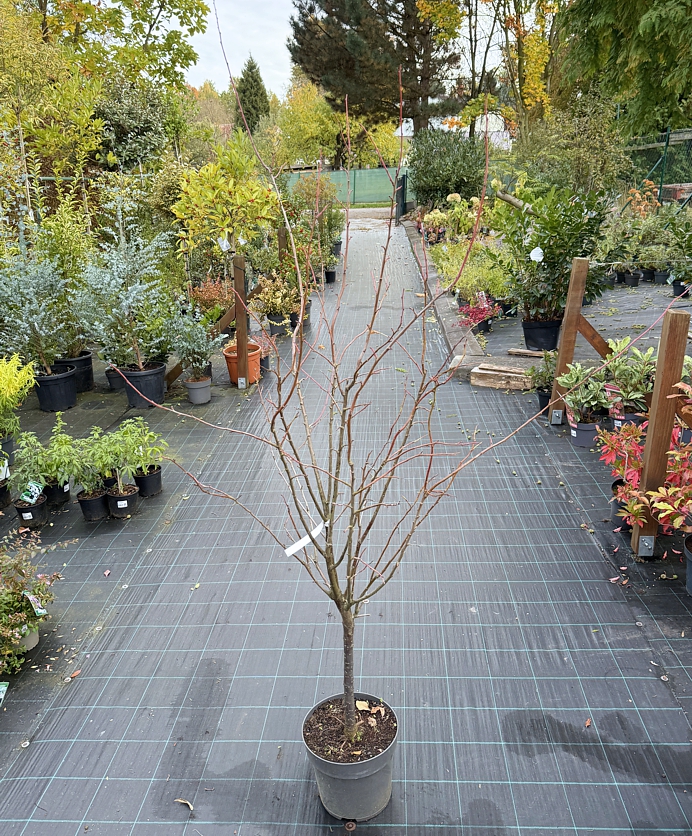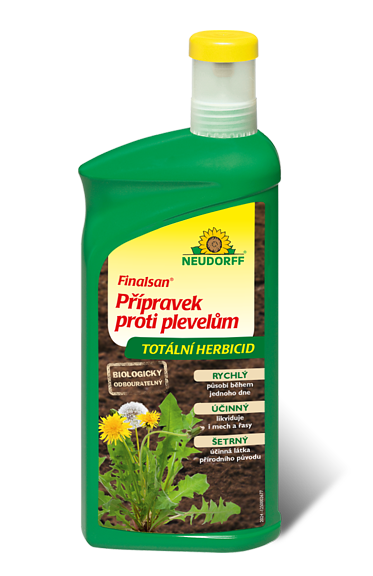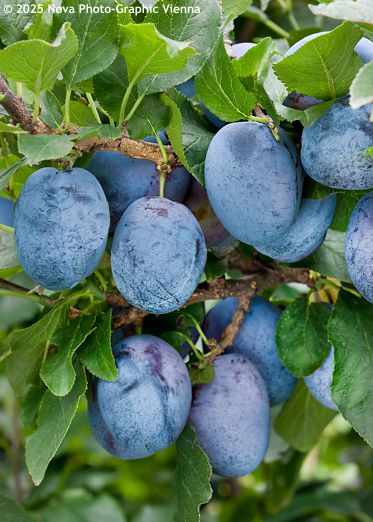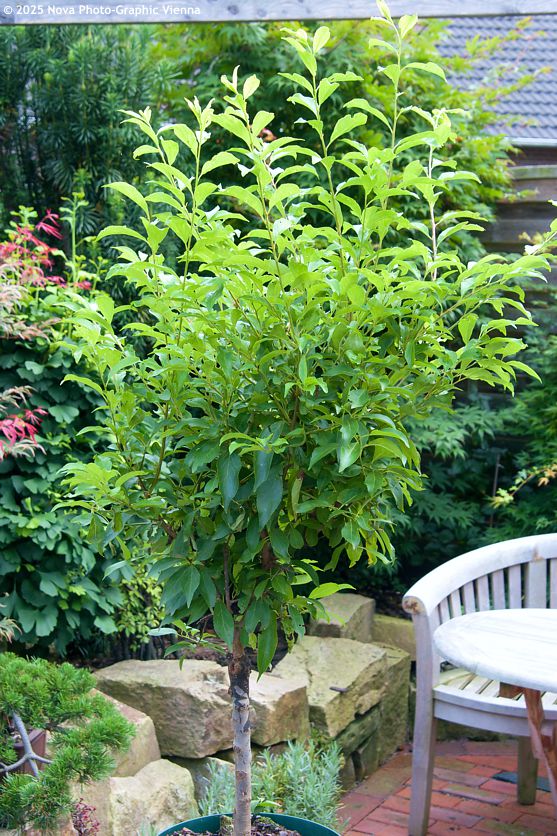Prunus domestica 'HANNA' dwarf plum tree
Prunus
The European plum (Prunus domestica) likely originates from the Caucasus region, where various wild forms of plums interbred until this cultivated species emerged. Botanically, it belongs to the rose family (Rosaceae), and its story is as tangled as its genetics – some say it’s a hybrid between sloe and wild plum. Today, it’s rarely found in the wild, but in gardens, it feels more at home than almost any other tree. In the Czech landscape, the plum has foundations steadier than many castles. It arrived with Slavic tribes around the 5th century AD and has since become an inseparable part of rural life. Even King Charles IV promoted the planting of plum orchards, and in the 15th and 16th centuries, Czech fruit growing experienced a golden age – plum trees outnumbered even apple trees.
In Czechia, plums were dried into so-called krajánky, used as sweeteners and Christmas decorations. Although compotes – fruit preserved in sweet syrup – date back to antiquity, they became most deeply rooted in Central and Eastern Europe as a clever way to preserve harvests for the long months of the absence of fresh produce. And plum compote? You’ll find it most often in Czechia and occasionally in neighbouring countries. But the greatest legacy we’ve preserved to this day is povidla – a dark purple paste made by slowly cooking overripe plums without added sugar. This method of preservation is unique to Central Europe and reached its peak in the Czech lands. As early as the 18th century, during the reign of Maria Theresa, povidla were cooked in copper kettles as a communal event, often lasting several days. In some villages, original fruit-drying houses still stand as a testament to the plum’s importance in our lives. While France gave the world dried plums from Agen (since 1815), and Italy and Portugal offer semi-dried delicacies, we gave the world povidla – a cultural export with the taste of home.
Hanna is a dwarf variety of European plum, seemingly made for urban gardens and terraces. It grows compactly, with a crown so neat you could plant it in a pot next to geraniums or any other handsome plant. It’s ideal for small spaces, reaching barely two meters in height. The fruits are medium-sized, oval, with a bluish-purple skin that shines like a velvet coat. The flesh is yellow to orange, juicy and sweet, and surprisingly high in quality, considering the often-compromised taste of dwarf fruit trees. The stone separates easily, which is appreciated by anyone who enjoys baking or making jam. The fruits are neither large nor small – just the right size – something between a damson and a true plum.
The tree blooms in May with white flowers that attract bees like a magnet. Hanna is self-fertile: it doesn’t need a pollination partner, so no complicated pairing with other varieties. It’s most often grafted onto slow-growing rootstocks like St. Julien or Wavit, which support its compact growth and suitability for containers. The fruits ripen from September to October, when most stone fruits have already been harvested. This way Hanna extends the fruit season, much like hardy kiwifruit or dwarf peaches.
As for care, Hanna is not picky. It prefers sun but tolerates partial shade. The soil should be well-drained, ideally calcareous or neutral, with a pH around 6.5. Watering, especially in containers where moisture escapes quickly, should be regular but cautious not to overwater. In containers, it’s best to protect it with burlap in winter or move it to a sheltered spot, and water it once a month to prevent complete drying. Do not consume the seeds hidden inside the stones of all stone fruits (except almonds) as they contain amygdalin, which can convert in the body to hydrogen cyanide, dangerous in larger doses. Hardiness is great – down to at least –27 °C, making it suitable for most temperate regions.
Last update 19-10-2025

1 479 Kč
Goods are shipped all over Europe. For Russia and U.K. and for further details please read about SHIPPING OPTIONS HERE.
Are you interested in a serious discount for orders NOV-FEB? Check your options here.
THE PRICES INCLUDE VAT of 15%. For quick conversion you can use 1 CZK = approx. 0.04 EUR
- STANDARD QUALITY - Plants of this group are 1st class quality with number of branches and overall density adequate to their size and age, considering they were container grown.
- DE LUXE QUALITY - This label guarantees a luxurious quality of manually selected plants that, compared to their height and age, are exceptionally dense and beautiful.
- EXTRA - These plants are usually mature and bigger specimens with exceptional overall appearance.
- STANDARD (as described in the plant form) means a tree with a trunk of 190-210 cm and a crown at the top, unless specified differently. The commercial size for trees is their girth measured in the height of 1m from ground.
- HOBBY - These plants are of the same quality as our standard-quality plants but younger and therefore cheaper.
- SHRUB - a woody plant with branches growing bushy from the ground level.
- HALF-STANDARD or MINI-STANDARD - a small tree with shorter trunk, its size is usually specified.
- FEATHERED - These are trees with branches growing already from the base of the trunk and up along the stem.
- GRASSES and PERENNIALS - Sizes given usually read the diameter of the pot or the clump, as specified.


































.jpg)


